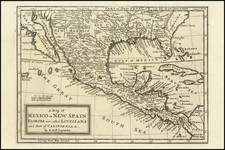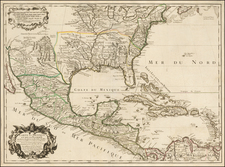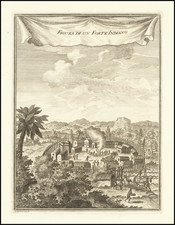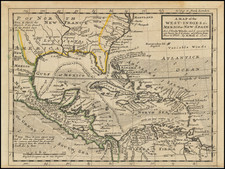Fine example of William Heather's remarkable sea chart of the coastal regions of the Southeastern United States, from Albermarle Sound to an area just south of Grenville Inlet near Palm Beach, Florida, just north of Ft. Lauderdale.
The map is extremely detailed, drawing upon the English and American surveys of the Southern Colonies conducted by De Brahm, Romans and others between the First Treaty of Peace in 1763 and the close of the American Revolution in 1785 and thereafter. The map also includes large detailed insets of the area around Charleston, Savannah, Port Royal and Cape Fear and is unquestionably one of the most detailed sea charts of the region published in the 18th Century. Its size and accuracy eclipse contemporary American charts by Matthew Clark, John Norman and Jonathan Price & John Strother. Among post-Revolutionary War sea charts of the Southeastern United States published during the 18th Century, only the rare 1784 Gerard Hulst Van Keulen and 1785 David Steel charts provide comparable detail, size and accuracy.
The prominently lettered location of Grenville (now Jupiter) Inlet on the map was not chance decision by Heather. By 1799, the importance of Grenville Inlet had significantly diminished. However, the location is of tremendous historical significance during the period following the French & Indian War. Originally appearing on explorer's maps as early as 1671, Jupiter Inlet was briefly named and almost certainly settled by the British prior to the American Revolution.
In 1763, the Spanish ceded Florida to Britain. Shortly thereafter, the land was apparently acquired by the family of Sir George Grenville, British Prime Minister under King George III from 1763 to 1765 and architect of the Stamp Act, among other infamous colonial acts. One of the first appearances of the name Grenville in the region appears on maps by Gerard De Brahm during this period, where he notes the presence of an inlet "Jupiter now Grenville." In his 1770 map, De Brahms also references the Loxahatchee River as being the Grenville River. The area was later surveyed by Bernard Romans in 1773, who notes that at the Mouth of the St. Lucy River, "Mr. De Brahm has honoured this with the name of Grenville River, on account of a tract of land here laid out for that gentleman . . ." When Florida was ceded back to Spain in 1783, the Grenville's family holdings in Florida were lost to the Spanish. While the Grenville settlement was not among the loses listed by the family, it was almost certainly among their assets 10 years earlier.
However, during this time, it appears that Grenville attempted to colonize and settle the region, making it the oldest English Settlement on the East Coast of North America. While historians have questioned the length of time the so-called Grenville Colony survived, evidence of its existence is relatively certain, based upon archaeological discoveries made during the excavations in 2000 in connection with the restoration of the Jupiter Lighthouse (built by the Americans in 1856). Grenville Inlet continued to appear in English Nautical Guide books until the 1830s, but seems to have largely disappeared thereafter.
William Heather is among the most important English Sea Chart publishers of the 18th Century. Heather began his business in 1765 as a publisher and dealer of sea charts and nautical instruments near the offices of the East India Company, under the sign of the "Little Midshipman," where he succeeded Mount & Page. The business was later to become known as "the Naval Academy" and "Navigation Warehouse," and was referenced by Charles Dickens in Dombey and Son. In 1768, the business became "Heather & Williams" and remained so until about 1812, when John William Norie, who had joined Heather in 1797 at age 25 and worked in the shop thereafter, became the proprietor.










![[St. Augustine, Florida] Beschreibung des Vorgebürgs Floride/ da die Franzosen anzufahren pflegen/welches von ihnen das Französische Vorgebürg genannt wirdt.](https://storage.googleapis.com/raremaps/img/small/84381.jpg)



![(Florida-Georgia) Wie der Franzosen Oberster eine Seul / daran das Wapen dess Königes auss Franckreich / aussrichten lassen. [How the French commander had a seal made, on which the coat of arms of the King of France is displayed.]](https://storage.googleapis.com/raremaps/img/small/95828.jpg)